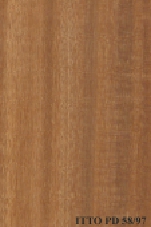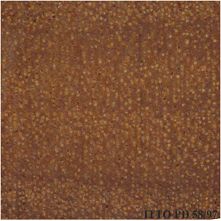
KOTIBé (Nesogordonia papaverifera)
Nom commercial
Kotibé
Nom scientifique (avec auteur)
Nesogordonia papaverifera R.Cap.
Famille
STERCULIACEAE
Noms communs (pays)
Kotibe (Côte d`Ivoire); Kissinhungo (Angola); Danta (United Kingdom); Kissnhungo (Angola); Kondofindo (Zaire); Aborbora (Gabon); Naouya (Central African Republic); Ovoui (Cameroon); Ovoe (Cameroon); Otutu (Nigeria); Danta (Ghana); Epro (Ghana); Akumaba (Ghana); Abumana (Ghana); Naouya (Angola); Owoe (Cameroon); Kotibe
Synonymes du nom scientifique (avec auteurs)
Cistanthera papaverifera A. Chev.
DESCRIPTION DE L'ARBRE
Description botanique
The tree reaches a height of 30 to 40 m. The bole is usually clear, cylindrical, straight to 13 to 26 m in length. The trunk diameter attains 80 to 120 cm over the short buttresses.
Habitat naturel
Nesogordonia fouassieri grows in dense stands, commonly in areas where savanna has been replaced by forest. It is found in mixed and dry deciduous forests and in transitional forests.It is known or inferred that the harvesting of specimens from the wild f
Répartition naturelle
West Africa, from Sierra Leone to Cameroon and Northern Gabon.
IDENTIFICATION DU BOIS
Description anatomique du bois
Wood diffuse porous. Occasionally vessels exclusively solitary (over 90%). Tangential diameter of vessel lumina 100 to 150 micras (small). Non-vestured pits. Vessels per mm2 more than 20 (very abundant). Simple perforation plates. Vessel-ray pits similar to int Apotracheal axial parenchyma diffuse and/or diffuse in aggregates. Axial parenchyma storied. Prismatic crystals in short chains in chambered axial parenchyma cells. 3 to 4 cells per parenchyma strand. 4 to 10 rays per mm (medium). Rays storied. Rays 1 to 4 seriate. Body ray cells procumbent with one row of upright and/or square marginal cells (Kribs-III). Non-septate fibers. Fibers with simple to minutely bordered pits.
-
 Vue macroscopique du bois (plan radiale)
Vue macroscopique du bois (plan radiale)
-
 Vue microscopique d'une section transversale du bois
Vue microscopique d'une section transversale du bois
Disponibilité
Statut CITES
Unrestricted
DESCRIPTION GÉNÉRALE DU BOIS
Teinte
The sapwood is pale, it has a thickness of 5 cm. The heartwood is red-brown, it is clearly demarcated. The silver figure is fine.
Index de Teinte (1 = Noir, 7 = Jaune clair)
4
Grain
Straight or slightly interlocked, sometimes with an influence on further processing operations.
Texture
The texture of the wood is fine.
Luster
This wood is commonly of low luster.
Durabilité naturelle
Moderately durable to decay. Without preservative treatment, this species can be used only under risk of occasional re-humidification. It is not suited for uses with risks of permanent or long-lasting humidification. Moderately resistant to termites attack
Index de durabilité naturelle (1 = Très élevée, 7 = Très faible)
3
Tensions internes de croissance
No residual growth stresses are found.
Teneur en silice
Silica Content: Silica content is negligible. Amounts over 0.05% may affect wood processing. Silica Value: 0.01
Résistance à l'imprégnation
Difficult to treat with only a low penetration of the preservative products.
PROPRIÉTÉS PHYSIQUES DU BOIS
Densité basale ou gravité spécifique (poids anhydre/vol. saturé) (g/cm³)
0.67
Densité sèche à l'air (poids et volume à 12%TH) (g/cm³)
0.76
Retrait tangentiel total (saturé à 0%TH) (%)
7.5
Retrait radial total (saturé à 0%TH) (%)
5.1
Calendrier de séchage en séchoir recommandé
FR-6
Ratio de stabilité dimensionnelle (% retrait tangentiel total/% retrait radial total)
1.5
Calendrier de séchage en séchoir
http://www.tropicaltimber.info/wp-content/uploads/2015/09/KD_French.pdf
PROPRIÉTÉS CHIMIQUES DU BOIS
PROPRIÉTÉS MÉCANIQUES DU BOIS
Résistance à la flexion (module de rupture_MOR) 12%TH (kgf/cm²)
1209
Rigidité (module d'élasticité_ MOE) 12%TH (kgf/cm²)
132681
Résistance à la compression parallèle à la fibre 12%TH (kgf/cm²)
677
Résistance à la compression perpendiculaire à la fibre 12%TH (kgf/cm²)
93
Résistance au cisaillement (radial) 12%TH (kgf/cm²)
99
Dureté Janka (latérale) 12%TH (kgf)
710
Dureté Janka (extrémités) 12%TH (kgf)
796
OUVRABILITÉ
Sciage
Sawing of this species requires powerful equipment.
Coupe de placage de déroulage
Suitable for slicing, also suitable for peeling if treated.
Placage tranche
Suitable for slicing, also suitable for peeling if treated.
Effet d'émoussement
Moderate blunting effect; stellited blades for sawing and carbide tools for machining are advised.
Usinage
It needs powerful tools for processing. Possible difficulties caused by interlocked grain are reported.
Rabotage
Moderately easy; tools must be cautiously sharpened.
Moulurage
Moderately easy; tools must be cautiously sharpened.
Tournage
30
Perçage
Moderately easy; tools must be cautiously sharpened.
Mortaisage
Moderately easy; tools must be cautiously sharpened.
Clouage
Pre-boring is necessary.
Collage
Glues well if basic gluing technical rules are followed.
Ponçage
Easy to perform; it gives good results.
Polissage
Can be polished without surface preparation.
Cintrage à la vapeur
This species can be used for steam bending.
Compatibilité avec outils manuels
Working with hand tools is difficult.
UTILISATIONS
UTILISATIONS FINALES (RÉSUMÉ)
HOUSING GENERAL, boards, flooring, parquet, frames, steps, panelling, fittings, FURNITURE AND CABINETS, luxury furniture, cabinets, PLYWOOD AND VENEER, faces, Decorative veneer, TURNING, ornaments, turned furniture, cutlery, lasts, TOOLS, tool handles, agricultural tools, CONTAINERS, truck bodies, truck flooring, NAVAL CONSTRUCTION, boat fins, boat oars, OTHER AND MUSICAL INSTRUMENTS, handicrafts
MEUBLES ET M. DE RANGEMENT
- 10 - Silica in Timbers
Planches
- 13 - Dry kiln schedules for commercial woods. Temperate and tropical. Section III. Latin American (Mexico, Central, and South America) Woods–Conventional Temperatures
Planchers
- 14 - Handbook of Hardwoods
Parquets
- 15 - Empire Timbers
Cadres
- 16 - Woods of the World
Marches
- 17 - Tree Conservation Database
Panneaux
- 18 - W3TROPICOS Missouri Botanical Garden
Accessoires en bois
- 19 - Silica in Timbers
MEUBLES ET M. DE RANGEMENT
- 21 - Tropical timbers of the world. Part III-Southeast Asian and Oceanian Species.
Meubles luxe
- 22 - Dry kiln schedules for commercial woods. Temperate and tropical. Section IV-Asian and Oceanian Woods
Armoires
- 24 - Empire Timbers
PANNEAUX ET PLACAGE
- 25 - Directory of Timber Trade Malaysia
Faces (de placage)
- 26 - Annual Review and Assessment of the World Timber Situation 1998-ITTO
Placage tranché
- 28 - Ministry of Agriculture, Fisheries & Forest of Fiji
Tournage
- 30 - Embassy of Honduras in Japan
Ornements
- 31 - Embassy of Colombia in Japan
Ornements
- 32 - Embassy of Cote d`Ivoire in Japan
Manches de couverts
- 33 - Embassy of Gabon in Japan
Formes à chaussures
- 34 - Embassy of Indonesia in Japan
OUTILS
- 42 - Utilización Industrial de Nuevas Especies Forestales en el Perú.
Outils_manches
- 43 - Maderas de Bolivia (Características y Usos de 55 Maderas Tropicales)
Outils_agric
- 44 - Atlas of Peruvian Woods
Carros_camion
- 53 - Timbers of the New World
Wagons
- 54 - Bulletin of the Government Forest Experiment Station N.157: Identification of Tropical Woods
CONSTRUCTION NAVALE
- 55 - Tropical Timber Atlas of Latin America
Navires_ponts
- 58 - Guía de Árboles de Bolivia
Navires_rames
- 60 - Amazonian Timbers, Characteristics and Utilization Volume II; Curuá-Una Experimental Forest Station
Artisanat
- 66 - Maderas latinoamericanas. VII. Caracteristicas anatomicas. propiedades fisicomecanicas, de secado, y tratabilidad de la madera juvenil de Cordia alliodora (Ruiz & Pav. Oken.)
Please Provide Information To View Producer Information